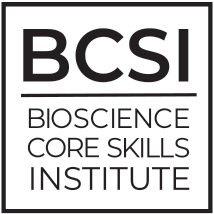Microcredentials
At Bioscience Core Skills Institute (BCSI), we offer practical skills assessments either on-site or at third-party locations. Customers receive an equipment list and assessment objectives.
We use digital archiving to maintain and display microcredentials to employers. These microcredentials can be accessed by clicking on a graphic image, providing information on objectives, mastery descriptions, and the assessment date. They can be shared on platforms like LinkedIn, SmartResume, or websites.
Our digital microcredentials are easily portable to all electronic documents. After assessment, recipients receive updates on new microcredentials, industry partnerships, and renewal reminders. Renewal is free with proof of practice or at a reduced cost through remote assessment.
ESSENTIAL FIVE microcredentials
These five microcredentials are a stackable set ensuring that you are prepared for an entry-level position in the biotech industry. Our microcredentials are unique as we require a 3rd party evaluator to assess mastery of this skill in person before issuing this credential.
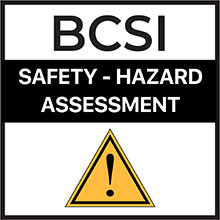
SAFETY: HAZARD ASSESSMENT
Lab safety is critical for a productive workplace. Industry partners highlight safety as an essential first skill that new employees must demonstrate. The lab safety-hazard assessment credential is for those wanting to demonstrate mastery of basic lab safety principles including how to identify safety concerns in an SOP, MSDS, and in a lab environment.
SAFETY: HAZARD ASSESSMENT
Lab safety is critical for a productive workplace. Industry partners highlight safety as an essential first skill that new employees must demonstrate. The lab safety-hazard assessment credential is for those wanting to demonstrate mastery of basic lab safety principles including how to identify safety concerns in an SOP, MSDS, and in a lab environment. Our microcredentials are unique as we require a 3rd party evaluator to assess mastery of this skill in person before issuing this credential.
Earners of this credential have shown mastery of the following tasks:
- Utilize information on an MSDS sheet.
- List safety steps needed to work in a particular lab environment.
- Describe safety hazards when viewing a lab bench.
GET READY
When you are ready to schedule your credential assessment, ensure that you can complete the tasks listed below:
- You will be asked questions about hazards present when handling a chemical. The MSDS sheet for the chemical will be provided.
- When provided an SOP describing lab work, you will be asked to describe appropriate PPE and safety considerations.
- You will be shown a lab bench with hazards present and asked to identify hazards.
COST
For your $20 credential fee you will be assessed in-person on the tasks listed above and issued a digital credential through Badgr. Our evaluators are available on a flexible schedule.

DOCUMENTATION AND SOP
DOCUMENTATION AND SOP
Ability to follow an SOP and evaluate a batch record.
Objective Measured:
- Communicate the answers to prompts about specific parts of an SOP.
- Evaluate an SOP for compliance with good documentation practice.
- Complete a batch record accurately.
Performance Assessed
- Student will be provided with an SOP and asked specific questions about the components.
- Student will be given an SOP with multiple errors that must be identified.
- Student will be asked to perform a simple task following an SOP to prepare a one ingredient solution. Upon completion of the task, student will be asked to fill out a batch record documenting the work completed.
Credential Alignment
- Washington Biotechnology/Biomedical Skill Standards
- D3. Enter and manage laboratory information electronically
- Data is entered accurately.
- Data is correctly cross-referenced and aligns with the linear progression of the work and the experiment methodologies and outcomes.
- C3. Review data and reports for compliance Data forms are complete, accurate, and legible and are completed in a timely manner. Standard operating procedures and guidelines are correctly documented.
Texas Biomanufacturing Skill Standards
- 1.1 Follow Standard Operating Procedures (SOPs)
- 1.2 Fill out batch records
- 1.3 Document and analyze data
BACE
Skills Category: Workplace Safety and Behavior
- Follow practices associated with regulatory compliance
- Demonstrate good documentation practices, including following Standard Operating Procedures (SOPs)
- Properly label items, including solutions, buffers, Petri plates, samples, and products
Core Skill Standards for Bioscience Technicians
- Critical Work Function: Comply with applicable regulations and standards
- Key Activities
- Follow established policies and procedures
- Record information according to established procedures
- Exercise proper document control
- Recognize and address nonconformances

Numeracy
NUMERACY
Numeracy skills are critical in a laboratory environment for preventing costly errors. Numeracy includes skills such as reasonableness, estimation of volumes and sizes, and unit conversions. This credential represents mastery of these numeracy skills that are needed in a biotechnology laboratory. Our microcredentials are unique as we require a 3rd party evaluator to assess mastery of this skill in person before issuing this credential.
- Earners of this credential have shown mastery of the following tasks:
- Recognize reasonableness of numbers in laboratory calculation results.
- Convert units within the metric system.
- Order numbers based on size.
- Write and record numbers accurately.
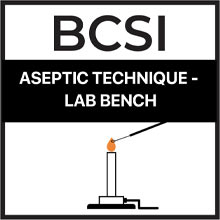
ASEPTIC TECHNIQUE: LAB BENCH LEVEL
ASEPTIC TECHNIQUE: LAB BENCH LEVEL
Transfer of sterile solutions and cultures at the lab bench.
Objectives Measured
- Prepare the lab bench surface for aseptic benchwork.
- Handle instruments such as Bunsen burner (or equivalent), striker, inoculating loop, test tubes, serological pipet, pipet pump, and agar plates appropriately
- Aseptically transfer a bacterial colony to a culture tube with broth media.
- Aseptically transfer a volume of sterile broth to a new sterile tube.
Performance Assessed
- Student will be given the task of transferring a bacterial colony.
- All materials are located and arranged to be efficient while transferring bacteria.
- Bunsen burner is lit appropriately and adjusted if necessary.
Credential Alignment
Texas Biomanufacturing Skills Standards
- 2.1.2 Personal protection equipment (PPE) such as gloves, eye protection, aprons and respirators are worn as needed
- 2.1.4 Appropriate agent(s) and amounts for cleaning are used
- 4.6.4 Proper aseptic techniques are followed.
- 6.1.2 Microbial growth is identified
- 6.1.7 Basic microbiology lab techniques are performed
Washington Skill Standards
- A4 Maintain biological stock cultures
- A6 Prepare biological and/or chemical materials
- B5 Handle and/or maintain biological stock cultures
BACE
- Skill category: Biotechnology
-
- Demonstrate proper aseptic/sterile technique
- Accurately measure liquids using micropipette and serological pipets
- Use of inoculating loop.
- Use of agar plate media.
- Use of culture tube with broth media.
- Handling of agar plate lid and test tube lids.
- Appropriate use of an inoculating loop to obtain a bacterial colony.
- Measure the volume indicated on a serological pipet (range of 1-9 mL).
- Aseptically transfer the volume to a new sterile tube.
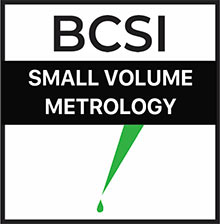
SMALL VOLUME METROLOGY
Accurate transfer of small volumes is an essential skill in the laboratory. This hands on assessment evaluates mastery of liquid transfer from 1 microliter to 25 milliliters. Earners of this credential are able to accurately select the appropriate transfer instrument (micropipette or serological pipette), consistently transfer the appropriate volume, and demonstrate volume awareness in selecting container size.
SMALL VOLUME METROLOGY
Pipetting volumes from 1 microliter to 25 milliliters
For employers: Individuals with this credential will be able to measure small volumes accurately and operate safely while performing measurement tasks.
Throughout the testing process, the credential earner should wear appropriate Personal Protective Equipment (PPE) and work safely. Volumes of liquid to be measured accurately will range from 1 microliter to 25 milliliters.
Required tasks to earn this credential
Credential earners will be asked to complete the following tasks while being observed by BCSI evaluators:
- Determine the appropriate device to use to deliver three different volumes (A, B, C) of liquid into new containers. Multiple aliquots of each volume will be delivered into new tubes. (For example 4 aliquots of Volume A, 4 aliquots of Volume B, etc.)
Performance Assessed
For each volume requested:
- Correct instrument is chosen based on the volume of liquid to be delivered.
- Correct tip is chosen when necessary.
- Interact with the following instruments and equipment appropriately:
- Serological pipet
- Pipette pump/controller
- Micropipette
- Micropipet tips
- Correct container/tube is chosen for delivering new volume.
- Disposal of tip or pipet is done appropriately.
- Accurate delivery of the volume into each new tube. (assessed by measuring weight)
Credential Alignment
Washington State
A1. Maintain laboratory and equipment
A3. Operate equipment
Knowledge of equipment operation and procedures for equipment such as pipette-aid, pipettmen, micropipettes, pH meter, centrifuge, scale, autoclave, or spectrophotometer, cleaning spatulas, stir bars and flow hoods.
Knowledge of equipment cleaning procedures and ability to keep equipment in good operating condition.
BACE
Skill Category: Biotechnology Skills
- Accurately measure liquids using micropipettes and serological pipets
Core Skill Standards for Bioscience Technicians
Critical Work Function: Perform measurements / tests / assays
Key Activities
- Collect samples according to established procedures and applicable sampling plans
- Prepare samples according to established procedures
- Follow appropriate test procedures/instructions
- Document data & results according to established procedures Interpret and/or analyze data & results as appropriate
ADVANCED microcredentials
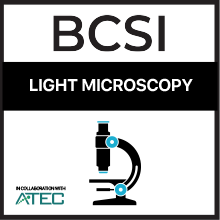
LIGHT MICROSCOPY
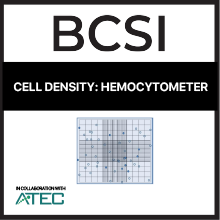
CELL DENSITY: HEMOCYTOMETER
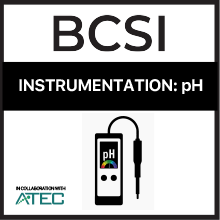
INSTRUMENTATION: PH
Instrumentation microcredentials ensure that a new employee has the skills to properly operate, maintain, and troubleshoot common laboratory equipment.
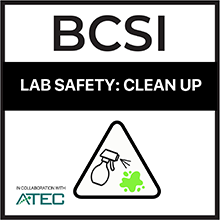
LAB SAFETY: CLEAN UP
Clean up of potentially hazardous spills and debris is an essential skill for laboratory employees. This hands on assessment evaluates whether credential earners can contain spills, clean up appropriately, and don appropriate PPE throughout.

PREPARATION OF SOLUTIONS
Preparation of solutions requires the ability to follow an SOP, select appropriate tools and perform basic calculations. Earners of this credential will be able to accurately and reliably prepare solutions needed in the laboratory.

QUANTITATIVE SKILLS I
Quantitative skills emphasizes tasks used in making solutions, calculating dosage, and performing calculations given a standard equation. The quantitative skills level 1 credential is for those wanting to demonstrate mastery of math skills needed in the laboratory.

Aseptic Technique: Biosafety Cabinet
Biosafety cabinets are essential tools in biotechnology, pharmaceutical, and research laboratories for protecting both products and personnel. The holder of this credential has demonstrated mastery of aseptic technique when working inside a certified biosafety cabinet (BSC). They can prepare materials and organize workflow to minimize contamination, perform sterile manipulations while maintaining proper cabinet airflow, and follow required biosafety and waste disposal protocols. This includes correct use of personal protective equipment (PPE), verification of cabinet function, and the ability to respond appropriately to contamination risks.
Aseptic Technique: Biosafety Cabinet
For employers:
The holder of this credential has demonstrated mastery of aseptic technique when working inside a certified biosafety cabinet (BSC). They can prepare materials and organize workflow to minimize contamination, perform sterile manipulations while maintaining proper cabinet airflow, and follow required biosafety and waste disposal protocols. This includes correct use of personal protective equipment (PPE), verification of cabinet function, and the ability to respond appropriately to contamination risks.
Performance Assessed:
- Correctly don PPE and verify BSC function before use
- Arrange and sanitize work zones within the BSC to maintain unidirectional airflow
- Use pipettes and transfer tools without introducing contamination
- Manage waste and materials to minimize cross-contamination
- Perform post-procedure cleaning and shutdown of the cabinet according to protocol
Credential Alignment
Washington State
A1. Maintain laboratory and equipment
A3. Operate equipment
Knowledge of equipment operation and procedures for equipment such as pipette-aid, pipettmen, micropipettes, pH meter, centrifuge, scale, autoclave, or spectrophotometer, cleaning spatulas, stir bars and flow hoods.
Knowledge of equipment cleaning procedures and ability to keep equipment in good operating condition.
BETA Skills microcredentials
The following microcredentials were developed in collaboration with the BETA Skills Community of Practice hosted by Forsyth Technical Community College.
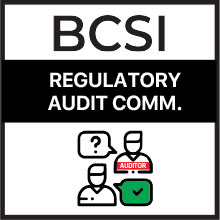
Regulatory Auditor Communication
Communicating with regulatory auditors is a common practice in the biomanufacturing industry. This mock interview assessment focuses on answering questions accurately, professionally, and succinctly, choosing verification of information instead of subjective opinions or speculation.

Current Good Documentation Practices
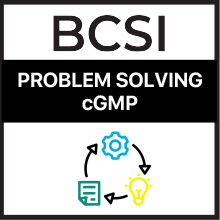
Problem Solving in a GMP Environment
Problem-solving is an essential skill in a GMP environment.
- Investigate
- Document
- Communicate
- Resolve
- Prevent
